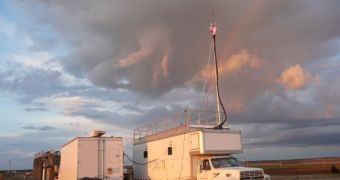A group of experts at the US Department of Energy's (DOE) Sandia National Laboratories (SNL) announce that they have finished designing and constructing a mobile atmospheric research facility that is based on two heavily-modified trucks.
The pair of heavy vehicles is outfitted with a vast suite of scientific instruments, which it can transport to any location accessible via road. Once they arrive at their destination, the duo sets up relatively fast, and can begin studies at a moment's notice.
Their primary use will be to track and identify the origin of greenhouse gases (GHG) emitted in Earth's atmosphere, helping the global effort to map the distribution and concentrations of these dangerous chemicals. Carbon dioxide (CO2) and methane (CH4) are the most potent GHG.
For officials looking to mitigate the impact of greenhouse gas emissions in their communities, regions, or states, knowing whether certain blobs of gases are biogenic (naturally-occurring) or anthropogenic (man-made) can make all the difference.
It is precisely because this type of information is scarce that global warming skeptics can dispute the scientific consensus on climate change. However, as more and more study instruments are built, skeptics are being denied this argument increasingly often.
“Information from this kind of facility should be useful to both researchers and policymakers,” explains SNL combustion and atmospheric chemist Hope Michelsen. She was one of the lead scientists on the new project.
“To figure out whether emissions reduction policies are effective, we need a way to measure emissions by emissions sector, such as power generation or transportation,” the expert goes on to say.
“We currently don’t have the tools in place to do these types of measurements, so we hope our idea can be part of the solution,” she argues. Indeed, having the ability to move a potent research and monitoring facility on a whim will contribute a great deal towards reducing uncertainties related to GHG origins.
In addition to CO2 and CH4, the two research trucks can also detect, measure and analyze sulfur dioxide (SO2), nitrogen oxide (NOx), carbon monoxide (CO), ozone (O3), and other traditional pollutants that stem from interactions among the GHG themselves.
At the same time, the SNL group is also working on developing more advanced research tools, detectors that will be a lot more sensitive to chemicals in the atmosphere than current technologies.
“Elected officials who have enacted new policies to help reduce unwanted greenhouse gas emissions could conceivably find a mobile facility to be of great use,” Michelsen explains.
“To figure out whether emissions reduction policies are effective, we need a way to measure emissions by emissions sector, such as power generation or transportation. We currently don’t have the tools in place to do these types of measurements, so we hope our idea can be part of the solution,” she concludes.

 14 DAY TRIAL //
14 DAY TRIAL //